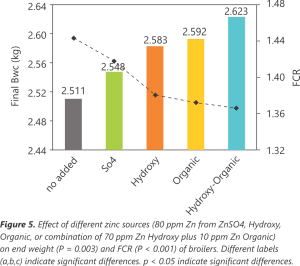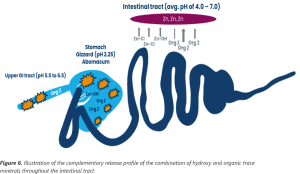In the intricate world of animal nutrition, the significance of supplementing trace elements like Zinc (Zn), Copper (Cu), Manganese (Mn), Iron (Fe), Iodine (I), and Selenium (Se) cannot be overstated. These elements play a pivotal role in ensuring the health and performance of livestock. However, the basal amounts of these trace elements found in standard commercial feeds simply fall short of meeting the animals’ requirements.
The key to unlocking the full potential of these vital trace elements lies in its bioavailability. Bioavailability refers to the retention of a trace element within the gut intestinal tract and is profoundly influenced by antagonistic interactions, particularly in poultry where phytate emerges as the arch-nemesis of essential trace minerals. Phytate forms stubborn complexes with these minerals, rendering them insoluble and thus unavailable for absorption. To combat this antagonism, numerous trace mineral sources have been developed based on solubility and chemical bonding.
But that’s not all; the timing and level of trace mineral delivery also come into play. This realization has led to a groundbreaking concept in trace mineral solutions – the fusion of organic and hydroxy minerals. This innovative approach has the potential to not only maintain but also elevate animal performance under various farm conditions. It’s imperative to emphasize that the proper timing and dosage of trace elements are paramount for ensuring optimal animal performance.
In today’s world, livestock producers face immense challenges due to stringent governmental regulations aimed at addressing environmental concerns. The novel ideas discussed above offer a glimmer of hope, promising improved absorption and reduced trace element supplementation, all while preserving production performance.
In Bonds We Trust: How Bonding Revolutionizes Trace Mineral Bioavailability
Commonly used trace mineral sources in animal nutrition include sulfate-based and oxide-based minerals, primarily chosen for their affordability. Sulfate trace minerals form ionic bonds with sulfate ligands, readily dissolving in water at a neutral pH, but their instability leads to complexation with phytate, reducing bioavailability. Conversely, oxide minerals form covalent bonds, rendering them insoluble in neutral pH and partially soluble in low pH, further hindering absorption.
To overcome these challenges, organic trace minerals and hydroxy trace minerals have emerged. Organic trace minerals shield metal centers with amino acids or proteinate ligands, limiting the formation of phytate complexes. Hydroxy trace minerals, with their unique covalent crystal structure, prevent phytate complexation and gradually dissolve at low pH, enhancing absorption. Additionally, hydroxy minerals boast cost-effective hydroxy and chloride ligands.
Comparative studies reveal that both organic and hydroxy trace minerals significantly outperform sulfate sources, with hydroxy and organic trace minerals yielding similar results. For instance, in broilers, hydroxy Zn and organic Zn show 144% and 142% improved bioavailability compared to Zinc sulfate (Figure 1).

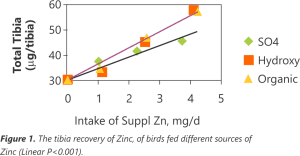
Particle size and density often go overlooked when selecting trace mineral sources. Ideal particle size and density minimize feed segregation and ensure proper mixability during production. These considerations are crucial, particularly for animals with low feed intake, as it guarantees that their limited consumption contains all vital nutrients, including minerals. This improved mixability can be done through a patented process (Optisize technology) of creating optimal particles that ensures particle size consistency and highly uniform. Confirmed through laser diffraction analysis, the process results in the ideal particle size (150-300 µm) with the ideal density (0.8-1.0 g/mL), whether it is zinc, iron or manganese, for improved blending/mixing, flowability, and reduce the carry-over risk.
Studies conducted with different trace element sources, such as MnSO4 and Hydroxy Mn, indicate improved mixing in complete feeds, enhancing feed quality and nutrient distribution. This is measured through an improve coefficient of variation or CV (lower % cv indicates better mixing, Figure 2). The mixability of trace elements in a diet is of particular importance to young animals, as they have a lower feed intake and therefore more important to get all the required nutrients, especially minerals, despite the low feed intake.

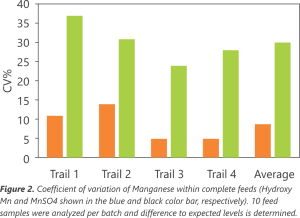
Furthermore, hydroxy minerals with spherical particles reduced “dustiness” of the product, leading to a lower dust potential (a lower number of dust potential indicates a lower loss of mineral source, see Figure 3) and this also lessens the chance inhalation of the product by workers in the feed mill or premix facility. Although a larger mineral particle size is preferred in feed or premix production, within the animal, it is the other way around. With a smaller particle size, this will lead to a larger surface area, allowing for an improved availability of the mineral.
The Strength of Synergy: The Power of Combining Organic and Hydroxy Trace Minerals
While the practice of combining different trace element sources is not new, recent developments have brought forth a game-changing concept: the 70:10 ratio of hydroxy to organic minerals. This innovation stems from the collaborative efforts of leading industry experts and academic professionals dedicated to optimizing animal productivity and well-being.

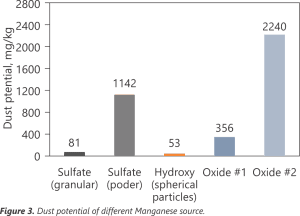
In another study, the results clearly showed that a combination of 70 ppm Zn from hydroxy mineral plus 10 ppm Zn from organic mineral was superior in terms of end body weight as well as improving feed conversion (Figure 5).

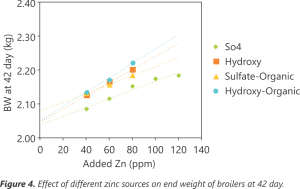
In conclusion, the choice of a trace mineral source is pivotal for supporting productivity,
